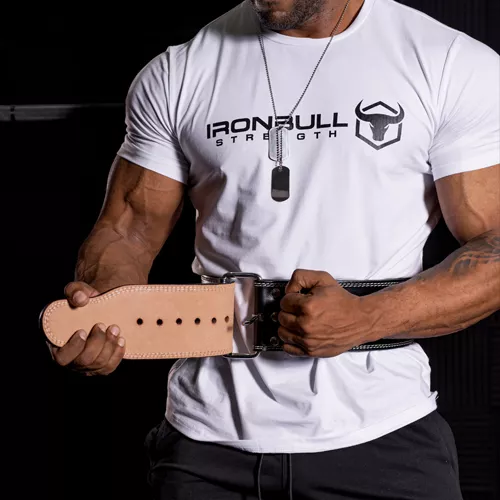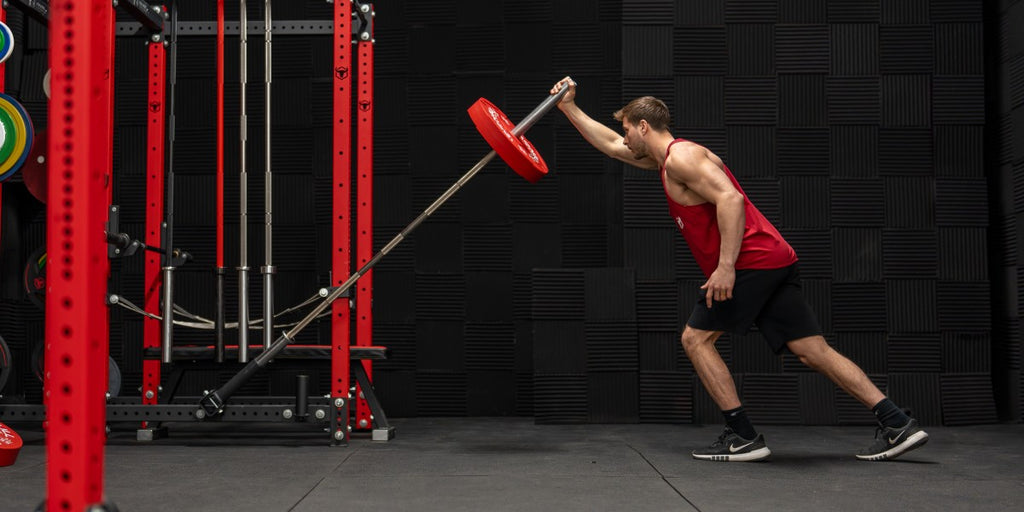Do Real Deadlifters Wear a Weightlifting Belt?

The other day at the gym, I saw a couple of young guys deadlifting. Along with the mandatory cell phone, they had a weightlifting belt - one between them. They made a big deal of strapping it on for every set before approaching the bar. It seemed like a ritual, a necessary step before starting their deadlift. But as I watched them go through their warm-up sets with that belt cinched tightly around their waists, I couldn't help but wonder: do belts help with deadlift? Have weightlifting belts for deadlifting become more of a crutch than a tool?
Let's investigate.

Understanding the Deadlift
Though it may seem simple (you just stand up, right?), proper deadlift form requires an understanding of biomechanics, muscle engagement, and the benefits of its many variations.
The deadlift is a classic strength training exercise that involves lifting a weighted barbell from the floor to a standing position. The exercise develops general body stability, grip strength, and posterior chain strength. It's a functional compound exercise involving movement through more than one joint (hips and knees).
While some people classify the deadlift as a back exercise, others put it in the leg category. It comes down to the deadlift variation you're doing. When you do the wide stance Sumo deadlift, the quads and inner thighs are the target muscles. The standard deadlift, which uses a hip-width stance, shifts the focus to the glutes, hamstrings, and lower back. Other variations are the rack pull, deficit deadlift, and Romanian deadlift, each with a different target muscle.
Your grip is very important for successful deadlifting. A firm grip gives the best force transfer from your muscles to the bar. It also prevents the bar from slipping from your hands. Include grip-focused exercises in your workouts to strengthen your hold on the bar. These could include farmer's walks, plate pinches, and static holds of the loaded bar.
The Science Behind Using a Belt for Deadlifts
Let's now dig into the evidence for and against the use of weightlifting belts for deadlifts:
Deadlift Weightlifting Belt Pros
Intra-Abdominal Pressure: Maintaining intra-abdominal pressure becomes crucial while lifting heavy weights. This is especially true during compound moves like the deadlift. This pressure acts as a natural girdle that supports the spine and lowers the chance of injury. Wearing a lifting belt increases abdominal pressure during the deadlift. It provides an extra layer of support to help you push your stomach against it. When you push your stomach against the belt, you brace the core. This naturally improves your deadlift form.
A 1999 study confirmed that wearing a weightlifting belt increases intra-abdominal pressure and spinal stability. (1)
Reduced Spinal Flexion and Compression: A weightlifting belt strengthens the lower back by applying pressure to the abdomen. This reduces the risk of unwanted spinal flexion. The increased stability keeps the spinal column in line during the deadlift. This reduces the risk of future injuries.
Wearing a belt has been shown to reduce spinal compression. A British Journal of Sports Medicine study showed less spinal compression when wearing a weightlifting belt. This suggests that a belt helps with trunk stability. (2)
Force Transfer: A snug-fitting weightlifting belt helps with force transfer during deadlifts. When you tighten your core, you produce tension as you tighten your core against the belt. This links your legs, hips, and the barbell together. The effective force transmission directs your lifting strength right at the bar, helping to prevent energy leaks.
You Can Lift More: The increased intra-abdominal pressure from pushing your abdominal wall against the belt will help you lift more weight. In-the-gym experience suggests that wearing a belt can increase your deadlift by 5-15%.
Reduced Perceived Effort: Some interesting research suggests that wearing a belt makes the weight feel easier to handle. A 2021 study had 20 healthy weightlifters perform the conventional deadlift with and without a belt, as well as with or without wrist straps, over eight weeks. All the lifters reported that the exercise felt easier when wearing the belt and straps. These results showed that wearing a belt and straps reduced the perceived effort among recreational lifters. (3)
Deadlift Weightlifting Belt Cons
Relying on Support: Using a weightlifting belt too much can cause you to rely on it. Your core and stabilizing muscles may not strengthen fully if the belt is used as a crutch. This could make it harder for you to lift weights without a belt. It may also hide core strength issues.
Reduced Flexibility and Mobility: A weightlifting belt can limit your natural flexibility and range of motion, especially in the lower back area. Overusing a belt could prevent you from fully involving your lower back and core muscles. This could harm both your lifting technique and long-term spinal health.
False Sense of Security: Wearing a belt could give you the idea that you're more secure. It can help keep your spine stable but cannot guarantee proper lifting technique. The belt won't protect you from damage if your form drops due to exhaustion or poor technique.
Who Should Wear a Belt for Deadlifts?
Wear a belt if:
- You're using near-max loads: Strap on a belt when you're lifting 80% or more of your one rep max.
- You have a lower back injury: Wearing a belt can give extra support for those with a back injury. It will make them less likely to reinjure it.
The following groups are better off without a belt:
- Beginners: Beginners should perfect their form and core strength before using a belt. Learning excellent deadlift form without using a belt should be a priority for new lifters.
- Lifters Focusing on Functional Strength and Core Activation: Some lifters, particularly those concentrating on functional strength and core activation, may choose not to use a belt during deadlifts to better involve their core muscles.
- People with High Blood Pressure: Increased intra-abdominal pressure may increase blood pressure. If you are likely to get high blood pressure, your best bet is to deadlift beltless.
When Should You Start Using a Belt for Deadlifts?
Beginners should not use a weightlifting belt. They need to build a solid foundation of good form and core strength. Deadlift training should focus the first six months on perfecting the basic movement pattern, using the core muscles, and developing general body awareness. This helps develop safe lifting practices without relying on a lifting belt.
Lifters with more than six months of training may introduce a belt but shouldn't use it for every set. It should be left for the last one or two max weight sets. These should have a rep range of 8 reps or less and involve 80% or more of your one-rep max.
How Should You Wear a Belt for Deadlifts?
Knowing how to wear a weightlifting belt properly while performing deadlifts will give you the best support without restricting your movement. Here's a step-by-step guide:
Choose the Correct Belt: Go for a well-fitting, high-quality weightlifting belt. It should be solid and sturdy, larger at the back and narrower in the front.
Positioning: Wrap the belt around your waist, just below the ribs and above the hip bone. If you're Sumo deadlifting, position it an inch lower. This provides greater support and better core bracing in the bottom position.
Tighten the Belt: Use the fastening mechanism to tighten the belt. It should be snug but not too tight. A couple of fingers should fit between the belt and your waist.
Engage the Core Muscles: Before beginning the lift, take a deep breath and press your belly against the belt to activate your core muscles. This produces intra-abdominal pressure, supporting bracing and core stability.
Best Belts for Deadlifts
There's a wide variety of weightlifting belts on the market, each with unique features. The best belt for deadlifting depends on your training focus and fastening preference. Here's an overview:
Powerlifting
Powerlifters need a belt with plenty of support and rigidity to handle maximum loads. Suede and leather are popular choices, with powerlifters usually preferring a standard width around the belt to maximize intra-abdominal pressure. Powerlifting belts should have a 10-13 mm thickness and heavy-duty prong or lever buckle.
[Related: Lever Belt vs. Prong Belt: Which One Is Better?]
Iron Bull strength powerlifting belts are market leaders. Check them out here.
Bodybuilding
Bodybuilders need a belt that is a bit more flexible than powerlifters. That's because you'll use the belt for a wider range of exercises. We recommend a tapered leather belt as this provides maximum back support while also allowing for more front-of-body freedom of movement. You'll want a fastening system to get the belt on and off between exercises quickly. Velcro and lever systems are popular.
Iron Bull Strength's Unleash 7mm Lifting Belt is the go-to support for many amateur and pro bodybuilders.
General Fitness
General fitness lifters need a belt that is even more flexible than bodybuilders. Nylon belts are ideal, being lightweight, flexible, and easy to secure. Choose a tapered belt to allow for unrestricted movement.
Iron Bull Strength's 6-inch reinforced nylon lifting belt is a favorite of gymgoers all over the planet.
CrossFit
CrossFitters demand a flexible, secure belt that won't get in the way and is quick to put on and discard. Nylon belts are preferred, being lightweight and user-friendly. Look for a belt with a 7-10 mm thickness that you can comfortably wear when going from a power move to cardio.
CrossFitters love the supportive comfort of the Iron Bull Strength 6-inch reinforced nylon belt.
Wrap-Up
A weightlifting belt is a tool to be used but not overused. Save it for your heaviest sets, where you lift 80% or more of your one rep max. Doing so will allow you to develop your core strength naturally. You'll also be able to keep your form solid without relying on the belt as a crutch.
By strapping on the belt for your business-end sets, you'll optimize intra-abdominal pressure, enhance core stability, and, ultimately, pull more poundage off the floor!
References:
- Cholewicki J, Juluru K, Radebold A, Panjabi MM, McGill SM. Lumbar spine stability can be augmented with an abdominal belt and/or increased intra-abdominal pressure. Eur Spine J. 1999;8(5):388-95. doi: 10.1007/s005860050192. PMID: 10552322; PMCID: PMC3611203.
- Bourne ND, Reilly TEffect of a weightlifting belt on spinal shrinkage.British Journal of Sports Medicine 1991;25:209-212.
- Fong SSM, Chung LMY, Gao Y, Lee JCW, Chang TC, Ma AWW. The influence of weightlifting belts and wrist straps on deadlift kinematics, time to complete a deadlift and rating of perceived exertion in male recreational weightlifters: An observational study. Medicine (Baltimore). 2022 Feb 18;101(7):e28918. doi: 10.1097/MD.0000000000028918. PMID: 35363215; PMCID: PMC9282110.










